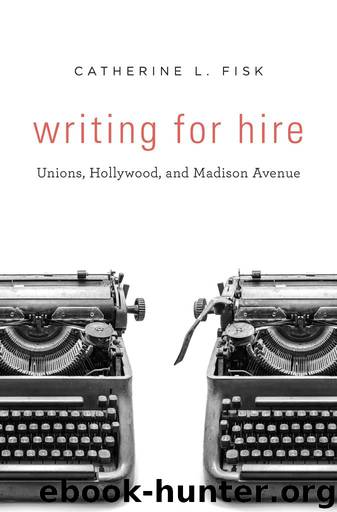Writing for Hire by Catherine L. Fisk

Author:Catherine L. Fisk
Language: eng
Format: mobi
ISBN: 9780674971400
Publisher: Harvard University Press
Published: 2016-10-16T16:00:00+00:00
Reuse Payments and Television
Having secured some forms of profit sharing and separated rights for film writers working for major studios, the Guild turned its attention to securing ownership and profit sharing in television. Independent television and film producers occasionally agreed to pay with a percentage of the profits, which writers considered one of the boons of the growth of independent production as the studio system began its decline in 1946. Profit sharing in this little segment of the industry, at least, achieved “the long-cherished dream of screen writers . . . to have a royalty in the earnings of the pictures they write.” Mary McCall, Jr., president of the SWG, gave a speech in early 1952 at the annual dinner of the Society of Independent Motion Picture Producers, an organization that existed between 1941 and 1958 to advance the interests of independent producers in the studio-dominated industry. McCall advocated that writers be paid a minimum fee plus a percentage of the gross. The next day, one small independent, Snader Telescriptions, called McCall to say that they were prepared to pay a flat fee of $500 plus three percent of the gross after the company had recouped $20,000. In negotiating with Snader, the size of the percentage was controversial, but the Guild thought it could get “what would be the greatest gain for writers we could possibly hope for—copyright in the name of the author as well as the proprietor.” But getting the right mix of guaranteed compensation and profit sharing and getting that agreement accepted by all the production companies proved to be a long fight.33
SWG negotiations with the Alliance (the trade association of movie and TV producers that negotiated with the talent guilds on behalf of all production company members) stalemated in the summer of 1952 over the issue of royalties. The Guild said it would negotiate on the amount of the advance payment, the percentage of the gross to be paid as a royalty, and the time at which the percentage would be paid, but it would not budge on the principle. As the demand for material to put on TV exceeded the supply of writers able to provide it, Guild negotiators thought they were in a good position to insist. The most contentious issue was the minimum advance against a percentage of gross revenues. Profit sharing required allocation of risk between writers and producers. The Guild offered a schedule of advances estimated so that the producer would have a return on “negative cost” before any further money must be paid to the writer, which essentially meant that writers absorbed much of the risk. The Guild hoped that by so doing, it could establish profit participation as a principle in most cases, without financial risk to the producer. But the television producers refused to discuss compensation on the basis that rights remained in the author subject to a long (seven year) lease to the producer. Instead, the Alliance proposed payment to the writer for all reuse, but not for each reuse, and only after a certain number of reuses or a certain period.
Download
This site does not store any files on its server. We only index and link to content provided by other sites. Please contact the content providers to delete copyright contents if any and email us, we'll remove relevant links or contents immediately.
| Air & Space | Construction |
| Disability | Educational Law & Legislation |
| Labor Law | Maritime |
| Military | Personal Injury |
| Sports |
Steroids: History, Science, and Issues by Standora Joan E.; Bogomolnik Alex; Slugocki Malgorzata(1195)
A Practical Guide to International Arbitration in London by Hilary Heilbron(1085)
Adrift by Steven Callahan(1033)
Reclaiming History by Vincent Bugliosi(1021)
Persuasion by Owner(1014)
The Nuremberg Interviews by Leon Goldensohn(991)
Dog Company: A True Story of American Soldiers Abandoned by Their High Command by Lynn Vincent & Roger Hill(980)
40 Days and 40 Nights by Matthew Chapman(969)
Poisoned by Jeff Benedict(960)
Last Narco by Beith Malcolm(936)
The New Whistleblower's Handbook by Stephen Kohn(921)
Introduction to the study and practice of law in a nutshell by Kenney F. Hegland(897)
Kafka's Last Trial by Benjamin Balint(849)
Lincoln's Code by John Fabian Witt(843)
A Passing Fury by A. T. Williams(826)
Japanese War Crimes during World War II: Atrocity and the Psychology of Collective Violence by Frank Jacob(812)
Eichmann in Jerusalem by Hannah Arendt(801)
Dog Company: A True Story of American Soldiers Abandoned by Their High Command by Roger Hill & Lynn Vincent(795)
A Court of Refuge by Ginger Lerner-Wren & Rebecca A. Eckland(786)
